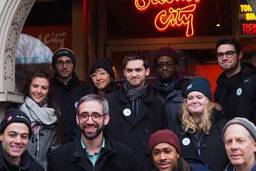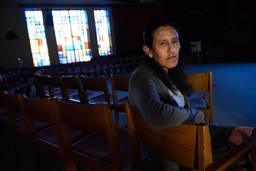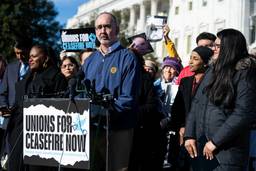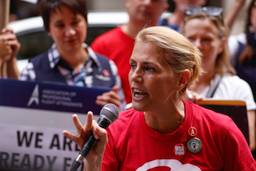
The upcoming leadership election for the Chicago Teachers Union, scheduled for May 17, is widely seen as a referendum on the first teachers strike in Chicago in 25 years.
The CTU-led strike this September galvanized thousands of teachers in mass marches calling on the mayor-appointed, millionaire-controlled Board of Education, to address education disparities that left some students sharing textbooks or fainting from the heat inside stifling, non-air-conditioned classrooms.
Now, an opposition group of teachers within the Chicago Teachers Union (CTU) has announced it will be running a slate in the upcoming election on the basis that the strike failed to achieve its objectives.
Tanya Saunders-Wolffe, the school counselor heading the ticket, told the Chicago Tribune that CTU president Karen Lewis should have pushed for more concessions from the city while teachers were in the streets.
“We struck, we fought, we gave Karen Lewis all the power she needed, but she didn’t deliver at the bargaining table,” said Saunders-Wolffe. As teachers are starting “to live the contract,” says Saunders-Wolffe, “they’re not very happy with the results they’re finding.”
Several teachers have told Working In These Times that while they left the strike with a renewed sense of unity and purpose, coming back to school has been a harsh reality. The longer school day pushed by Rahm Emanuel is now in place. And while CTU won contract concessions from the city, such as ensuring books for all students on the first day of school and lowering the weight of student evaluations in determining teacher salaries, many of the gains were Band-aids on the deeper problems of long-neglected schools.
But several members of Karen Lewis’ caucus interviewed by Working In These Times said that the opposition misses the picture by failing to see the Chicago teachers strike, and its outcome, in a national context of unions and public education reform.
“At a time when most teachers unions are buckling under the pressure of neoliberal reform, we weren’t going to win everything from a strike — we are still going to have to fight and fight,” says Jennifer Johnson, a history teacher at Lincoln Park High School and a member of the Caucus of Rank and File Educators (CORE) steering committee. “There is a lack of real understanding of what could have been lost without striking and without being a much more progressive union,” she adds.
CORE, led by Lewis, won control of CTU in 2010 on a platform of progressivism and grassroots activism. The group challenging Lewis includes two people who worked under former CTU president Marilyn Stewart, whose United Progressive Caucus was deposed by CORE and had been criticized in the past for its handling of school closures and little union democracy.
The opposition’s main criticism of Lewis is that she voted for Senate Bill 7, legislation that curtailed what the union could bargain about and mandated that 75 percent of the membership would need to vote in favor of a strike for teachers to go out. However, 90 percent of teachers ended up voting to authorize a strike.
The other argument made by Saunders-Wolffe’s group is that the union should have pressed for a moratorium on school closings while it had thousands of striking members on the street.
On February 14, the city announced plans to close 129 elementary schools, mostly in the Black and Latino neighborhoods of the South and West Sides. Amid rising violence in Chicago, school closings have been correlated with rising violence in some communities. Twenty-one communities on the South and West Side saw more than 53 percent of school closings since 2001 — they were also leading in youth homicides.
The closings could put a number of union teachers out of work, a trend that the CTU says disproportionately affects black teachers working in low-income schools. The opposition slate includes two teachers whose schools are on the preliminary list of schools that are targeted for closure.
Alison Eichhorn, a teacher at Peace and Education Coalition High School, an alternative high school for students who dropped out or were forced to leave their schools, says that while the opposition concerns could speak to some teachers, they may not understand the real way to win the fight against school closings.
“School closings were literally something that could not be discussed, that we could not bargain for,” she says, referring to the provisions in Senate Bill 7.
“The struggle with some unions, and especially with the teachers union, is that they are not always successful if they are not an activist union,” continues Eichhorn, who is a member of CORE and the daughter of a union carpenter. “[Closings are] something we fight on the ground. That’s an activist ‚fight not a contract fight.”
Johnson says that dissent within the union is part of democracy, but notes that “ultimately the contract passed with a 79 percent vote.”
“We were able to hold the line on a lot of really important basic issues, including pay for experience,” she says. “Considering what other school districts are being forced to take, we are coming out in a better position than if we had not put thousands of people in the street.”

I hope you found this article important. Before you leave, I want to ask you to consider supporting our work with a donation. In These Times needs readers like you to help sustain our mission. We don’t depend on—or want—corporate advertising or deep-pocketed billionaires to fund our journalism. We’re supported by you, the reader, so we can focus on covering the issues that matter most to the progressive movement without fear or compromise.
Our work isn’t hidden behind a paywall because of people like you who support our journalism. We want to keep it that way. If you value the work we do and the movements we cover, please consider donating to In These Times.






